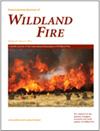澳大利亚火灾危险等级系统研究原型:气候学†。
IF 2.9
3区 农林科学
Q1 FORESTRY
引用次数: 2
摘要
背景 火灾天气现象的历史记录为了解空间和时间趋势提供了宝贵的资料,可为进一步的研究提供信息,也是规划的重要工具。目的 我们概述了新的澳大利亚火灾危险分级系统的研究原型(AFDRSRP)的 19 年气候,记录了其空间和时间特征。方法 分析利用了澳大利亚气象局的高分辨率再分析套件 (BARRA),以及澳大利亚消防机构提供的燃料数据。我们研究了 AFDRSRP 的空间和时间分布。我们按照燃料类型对分布进行了分类,分析了不同时间和空间的相对可变性。主要结果 结果验证了新系统的广泛特性,并深入分析了澳大利亚各地的火险变化情况,为了解昼夜和年度火险峰值的时间提供了更多细节。结论 虽然 AFDRSRP 在火险等级分类和算法调整方面与业务系统有所不同,但它为业务实施提供了有用的见解。意义 这些结果对于火灾季节的规划工作至关重要。本文章由计算机程序翻译,如有差异,请以英文原文为准。
Australian Fire Danger Rating System Research Prototype: a climatology†
Background Historical records of fire weather phenomena provide valuable insights into spatial and temporal trends which can inform further research and are important tools for planning. Aims We outline a 19-year climatology of a Research Prototype (AFDRSRP), of the new Australian Fire Danger Rating System, documenting its spatial and temporal characteristics. Methods The analysis utilises the Australian Bureau of Meteorology’s high-resolution reanalysis suite (BARRA), together with fuel data provided by Australian fire agencies. We examine the spatial and temporal distribution of the AFDRSRP. Distributions are categorised by fuel type, analysing relative variability across time and space. Key results The results validate the broad behaviour of the new system and provide insight into the variation of fire danger throughout Australia, adding detail to the understanding of timing of peak fire danger both diurnally and annually. Conclusions While the AFDRSRP differs from the operational system in its fire danger rating categories and tuning of algorithms, it nonetheless provides useful insights into the operational implementation. Implications These results will be essential for planning during fire seasons.
求助全文
通过发布文献求助,成功后即可免费获取论文全文。
去求助
来源期刊
CiteScore
5.50
自引率
9.70%
发文量
67
审稿时长
12-24 weeks
期刊介绍:
International Journal of Wildland Fire publishes new and significant articles that advance basic and applied research concerning wildland fire. Published papers aim to assist in the understanding of the basic principles of fire as a process, its ecological impact at the stand level and the landscape level, modelling fire and its effects, as well as presenting information on how to effectively and efficiently manage fire. The journal has an international perspective, since wildland fire plays a major social, economic and ecological role around the globe.
The International Journal of Wildland Fire is published on behalf of the International Association of Wildland Fire.

 求助内容:
求助内容: 应助结果提醒方式:
应助结果提醒方式:


